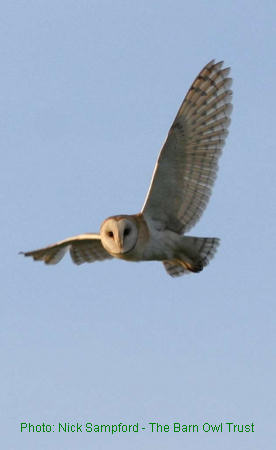The Barn Owl
 |
Although a small bird, weighing only around 350g, the wing span is 85cm and enables the owl to glide and sail over grassland with apparent effortless wing beats. The Barn Owl hunts predominantly by hearing prey in the long grass. It can hunt by sight, but its bright colouring puts it at a disadvantage as it is easily seen. Diet is made up of small mammals, in particular short tailed voles, but it will take shrews and even small rats.
Barn Owls roost and nest in old tree cavities and in old buildings. They will take residence in a variety of man-made nest boxes including tea chests in buildings, boxes mounted in trees and on poles. The breeding season usually starts in April but it can be delayed if the weather conditions are bad.
The UK population is estimated at between 3,000 and 5,000 pairs. Barn Owls can be found throughout most of the UK, but not at high altitude.
Status within Montgomeryshire
As elsewhere in Britain, the Barn Owl has been in decline over a long period of time in Montgomeryshire. Farming practice mechanisation, use of pesticides, changes in grazing management, loss of old trees and buildings, road development and many other factors have seen a severe reduction in numbers compared to the 19th century.
The Barn Owl population within Montgomeryshire fluctuates with influences such as prey availability and weather. In recent years, the highest population count has been 73 pairs in 2005. However, the lowest count was recorded in 2013 when the hard winter and heavy snowfall of early 2013 devastated Barn Owls. Just 14 breeding pairs were successful in 2013 and all were found west of Caersws, where lower altitude and proximity to the coast gave some protection from the snow.